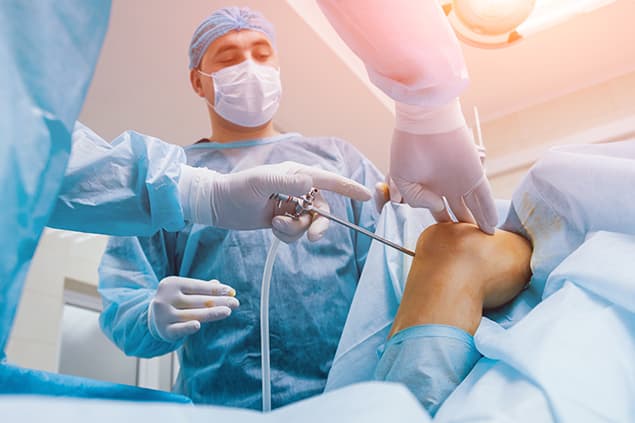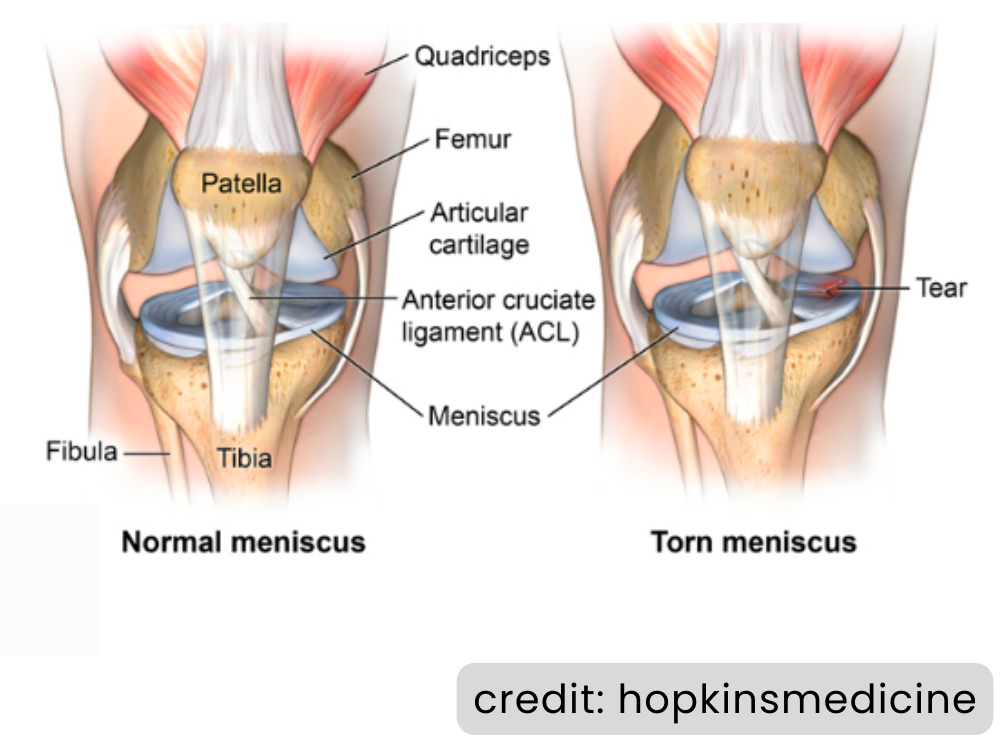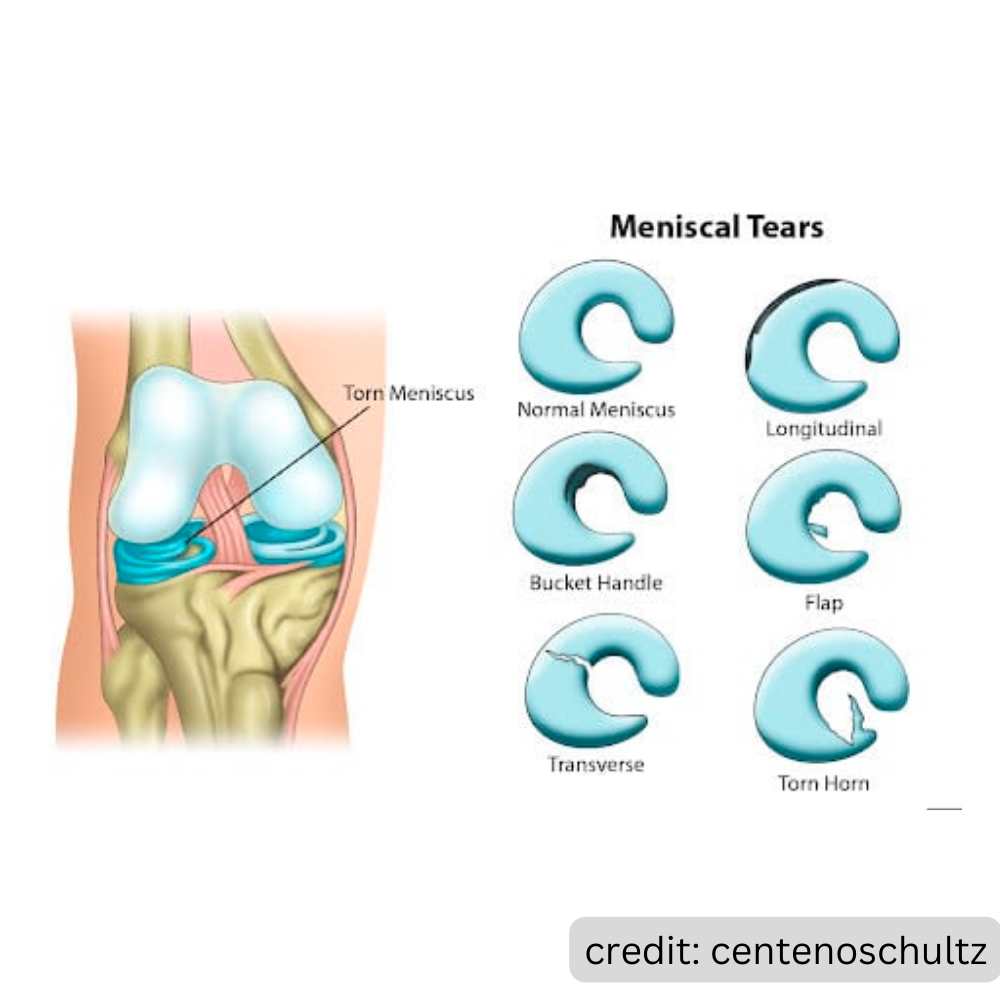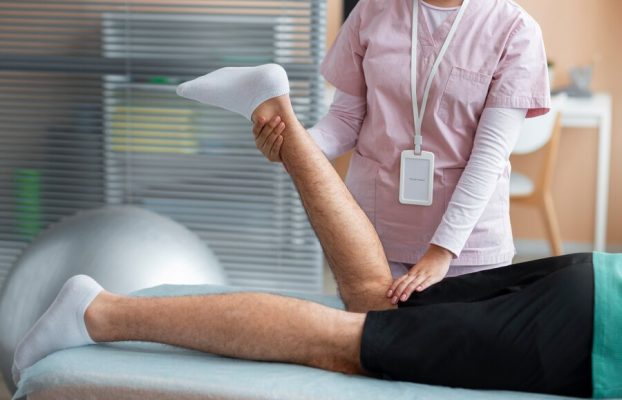Meniscus Repair
Diagnosis And Treatment Of Torn Meniscus
Seek immediate care for meniscus tears caused by injuries or wear and tear. Quick treatment helps to limit the injury. Get help from fellowship-trained orthopaedic surgeons to get back on your feet with a robust and healthy knee.

What Is The Meniscus?
The meniscus is a crucial cartilage in your knee that acts like a shock absorber between your thigh bone and shinbone. There are two menisci in each knee, and they help distribute weight and reduce friction during movement. Injuries to the meniscus can occur from sports, accidents, or gradual wear and tear, leading to pain, swelling, and difficulty moving the knee.
What Is A Torn Meniscus?
A torn meniscus represents a critical disruption in the knee's internal architecture, commonly arising from rotational forces imposed during dynamic physical activities or due to the gradual degradation associated with ageing. This injury not only underscores the vulnerability of the knee's complex mechanism but also serves as a poignant reminder of the balance between resilience and fragility within human anatomy. Characterised by symptoms that range from pain and swelling to compromised mobility, the torn meniscus challenges both the individual's physical capacity and psychological fortitude, pressing for innovative approaches in medical intervention and rehabilitation strategies.


What Are The Symptoms Of Meniscus Tear?
The symptoms can vary depending on the severity and location of the tear, but they generally include:
- Pain: Often localised on the side of the knee where the tear occurred, the pain may worsen when pressing on the meniscus, during movement, or when bearing weight on the knee.
- Swelling: The knee may swell due to inflammation caused by the injury. Swelling can occur immediately or be delayed by a few hours post-injury.
- Stiffness and Restricted Movement: You might struggle to straighten or bend your knee fully. The joint’s range of motion could be limited by pain or swelling.
- Locking or Catching: The knee may catch or feel like it’s locking during movement. Sometimes, you might be unable to straighten it entirely if a piece of torn cartilage blocks the knee joint.
- The feeling of Instability: There might be a sensation that the knee is giving way or unable to support your weight, especially when turning or twisting.
These symptoms can appear with varying intensity and may sometimes be mistaken for other knee problems. Therefore, a professional evaluation is crucial for an accurate diagnosis and appropriate treatment plan.
Diagnosing and Treating a Torn Meniscus
How Do We Diagnose Meniscus Tear?
Diagnosing a meniscus tear involves several steps, each crucial for ensuring an accurate understanding of the injury’s extent and nature. Here’s a structured approach to analysing this common yet complex knee issue:
Medical History and Physical Examination:
- History: The doctor will first gather detailed information about how the injury occurred, any previous knee injuries, and the specific symptoms you’re experiencing.
- Physical Exam: Various manoeuvres are performed to stress the meniscus and check for pain, tenderness, swelling, or mobility issues. One standard test is the McMurray test, where the doctor bends, straightens, and rotates your knee; a clicking sound or pain can indicate a meniscus tear.
- McMurray test: During the McMurray test, we rotate your knee to check for pain and click. The rotation can strain the meniscus, leading to an audible click. This helps us identify potential cartilage tears in your knee. Sometimes, if you’re in pain, we may skip this test.
- X-rays: Torn knee cartilage is invisible on X-rays, yet we must still conduct them to uncover any underlying issues that mimic its symptoms.
- Magnetic resonance imaging (MRI): If we suspect a cartilage tear, an MRI of the knee helps us see the meniscus clearly and provides intricate images of your knee’s tissues. This enables us to identify the specific nature of the meniscus tear, aiding in the surgical planning for its repair. According to RESEARCH: The Diagnosis of Meniscus Tears
The Role of MRI and Clinical Examination, it has been suggested that
“MRI before therapeutic arthroscopy for clinically diagnosed meniscus tears will reduce the number and cost of unnecessary invasive procedures.”
- Arthroscopy: Get ready for the ultimate Meniscus Tear Surgery experience with our skilled surgeons. We excel at customising arthroscopy procedures to guarantee optimal results for you. Through cutting-edge techniques, we perform minimally invasive arthroscopy to diagnose and treat knee problems effectively. Trust us for precise and impactful care tailored to your knee health needs.
How Is The Surgery Performed?
You will be given general anaesthesia, and once this has taken effect, the surgeon will make 2 small incisions over the front of the knee to do an arthroscopic examination of the knee and to tidy up the meniscus tear. The edges of the meniscus tear are then freshened up before small specialised implants are inserted to hold the tear together. These implants can be made of bio-inert materials or suture materials, and they are placed such that they would not impede knee movement during physical activities.
At the end of the surgery, local anaesthesia will be infiltrated around the wounds or a nerve block might be given near the knee to optimise post op pain control. Waterproof dressings will be applied over the wounds. A shower cover will be also provided so that you can shower with no fear of getting the dressings wet or causing them to fall off. A rigid knee brace and crutches will be provided before discharge.
When do I need a Meniscus repair?
Meniscus repair might be needed based on these critical factors:
- Type and Location of Tear: Repairs are more successful for tears in areas with good blood supply, typically on the meniscus’s outer edge.
- Age and Health: Younger, healthier individuals may benefit more from repair, especially if active, to maintain knee function.
- Symptoms: Significant pain, locking, or instability despite conservative treatments might require surgical intervention.
- Activity Level: Active people or athletes preferring to return to high activity levels might opt for repair to preserve the meniscus.
- Joint Health Goals: Repair can help preserve knee stability and reduce future arthritis risk.
The decision involves weighing these aspects with your doctor, considering your lifestyle and long-term knee health.
Will I be able to achieve full recovery?
Following meniscus repair, most patients fully recover and return to sports. After surgery, regular clinic visits for dressing changes occur every 4 to 5 days until the two-week mark. Physiotherapy, starting bi-weekly, aids in muscle recovery and strength. Competitive sports can resume in about six months, with light jogging possible at three months post-op. Office work can restart after dressings are removed in 2 weeks. In a small group of older patients, with degenerative tears, their prognosis with arthroscopic repair may not the same as the younger patients. A good discussion with the surgeon will be necessary to achieve a good outcome.
Here are some tips for recovery after meniscus repair surgery by Dr. Veera Reddy.
How should I protect my knees?: Meniscus Tear Prevention
Preventing a cartilage tear is critical to maintaining an active, pain-free lifestyle. While some accidents are unavoidable, there are strategies to reduce your risk significantly. Our clinic focuses on treating injuries and educating and equipping you with the tools to prevent them. Here are some tips to keep your knees strong and resilient:
Strengthen and Stabilise
- Targeted Exercises: Incorporate exercises that strengthen the muscles around your knees, such as the quadriceps and hamstrings. Strong muscles support and stabilise your knee, reducing the strain on your meniscus.
- Core Stability: A strong core supports your lower body, including your knees. Engage in exercises that improve your core strength and balance, which can prevent falls and awkward movements leading to injury.
Screening For New Patients
We have assembled some packages to help our new patients.
Single Knee
$235
Evaluation of Knee Pain with X-ray
Both Knees
$275
Evaluation of Knee Pain with X-ray
Flexibility Matters
- Regular Stretching: Flexibility aids in maintaining a full range of motion, decreasing the likelihood of injuries that could tear the meniscus. Include stretching in your daily routine, focusing on your lower body.
- Yoga and Pilates: These practices enhance flexibility, core strength, and balance, contributing to knee health and injury prevention.
Smart Training Techniques
- Proper Equipment: Wear supportive footwear tailored to your activity. Appropriate shoes can absorb shock and offer stability, reducing knee stress.
- Gradual Intensity Increase: Avoid sudden increases in workout intensity or duration. Gradually ramp up your activity to give your body time to adjust, preventing overuse injuries.
- Cross-Training: Engage in a variety of exercises to ensure balanced muscle development and reduce repetitive stress on any one part of the knee.
Lifestyle and Nutrition
- Healthy Weight Maintenance: Excess weight puts additional pressure on your knees. Maintaining a healthy weight through diet and exercise can significantly reduce the risk of Torn meniscus.
- Nutrition for Joint Health: Consume a diet rich in calcium, vitamin D, and anti-inflammatory foods to support bone health and reduce inflammation, further protecting your knees from injury.
Listen to Your Body
- Rest and Recovery: Give your body time to rest between intense workouts. Overworking your knees can lead to injuries, including Cartilage Tear.
- Seek Early Intervention: Consult with our specialists at the first sign of knee discomfort. Early intervention can prevent minor issues from escalating into serious injuries.
Frequently Asked Question
Have questions? Our specialists are here to answer them, providing you with the knowledge and confidence to make informed decisions about your health.
Before surgery, preoperative physical therapy is recommended to enhance muscle strength around the knee, improve joint mobility, and minimise oedema. This prehabilitation optimises your postoperative recovery trajectory. Patients are required to abstain from food and drink for six hours before surgery to mitigate risks during anaesthesia. Additionally, avoiding skin irritants like plasters or topical medications near the surgical site is crucial to prevent allergic reactions.
Health insurance typically covers meniscus repair due to its common occurrence and vital importance. Check your policy for coverage specifics like copayments and deductibles. The following are some of the insurance providers in Singapore for hip and knee Orthopedics.
Medisave
NTUC Singapore
AIA Singapore (extended panel)
Prudential Singapore (extended panel)
Great Eastern Singapore
Single Medical Insurance
HSBC Life Shield
A minor meniscus tear can often be effectively treated with conservative methods like the RICE protocol, physical therapy, and NSAIDs. These approaches help decrease inflammation and support healing of the meniscal tissue, potentially preventing the need for surgery in milder cases.
The procedure fee of meniscus repair will cost between $8000 to 10000. The total fee, inclusive of implants, consumables, anaesthesia fee, and facility fee may cost between $20000 to $30000. Total costs will vary between the private hospitals, ward class type and duration of stay. It is crucial for patients to carefully review their health insurance plans, such as Integrated Shield Plans, MediShield Life, and MediSave, to determine coverage and potential expenses.
Meniscus repair, like any surgery, comes with risks such as infection, bleeding, nerve damage, and post-op issues. However, the procedure is typically low to moderate risk thanks to cutting-edge arthroscopic methods and skilled surgeons with specialised training. Thorough pre-surgery assessments and closely watched post-op care are crucial for reducing potential complications and guaranteeing a smooth recovery.
Restoring a torn meniscus is crucial for regaining full knee function, relieving pain, and preventing complications like osteoarthritis. Surgery aims to preserve the meniscus structure, ensuring joint stability and proper distribution of forces in the knee for optimal long-term health. Consult an orthopaedic specialist to make an informed decision based on your unique condition, symptoms, and lifestyle requirements.
More Than 20 Years of Clinical Experience
Double Fellowship Trained Surgeons

Dr Tan Sok Chuen
Orthopaedic Surgery Specialist
Dr. Tan is an orthopaedic doctor with subspecialty training in hip and knee surgery – making her the first female hip and knee replacement surgeon in Singapore

Dr Adrian Lau
Orthopaedic Surgery Specialist
Dr. Adrian Lau is a specialist orthopaedic surgeon trained in primary and complex hip and knee arthroplasty. He was awarded the Ministry of Health Training Award in 2014.
Our Clinic
Address
38 Irrawaddy Road,
Mount Elizabeth Novena Specialist Centre,
#09-21/38, Singapore 329563
Opening Hours
Monday to Friday: 9 am to 5 pm
Saturday: 9am to 1pm
Closed on Sundays and Public Holidays
Latest Articles
Read from Our Blog
Our doctors share their journeys as orthopaedic surgeons as well as offer insights and tips.









